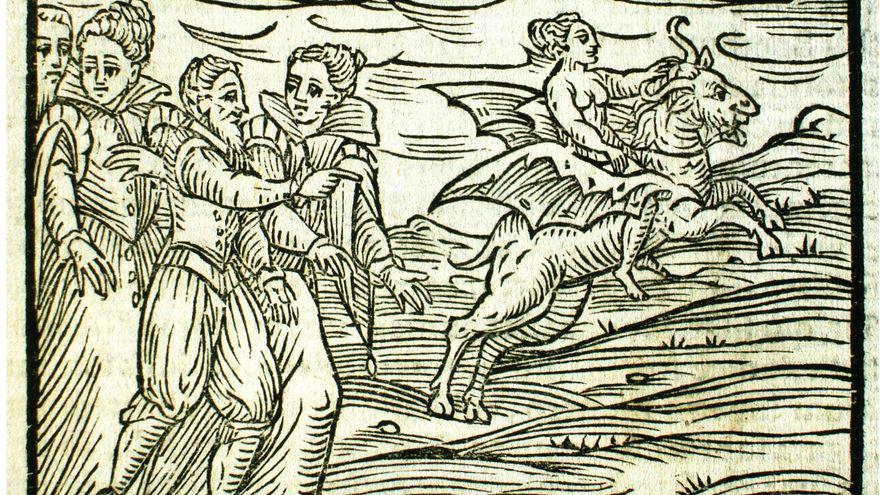Why do witches ride a broom?: This is how artists and inquisitors reflected them
History has left dozens of paintings and illustrations over the centuries that help to understand how during the 16th and 17th centuries, with the beginning of the Modern Age, there was a large part of society that dragged along medieval beliefs and blamed plagues, famines, great exoduses and wars to the figure of the devil. Hence, the persecution of heretics was intensified based on a generation of theologians who showed their fear of the future due to magical beliefs and superstitions inherited from the past, where witches play a fundamental role. This was reflected in numerous writings produced by the Inquisition and have been the subject of study by Professor María Jesús Calvo in a recent seminar at the Faculty of Humanities in Toledo.
This expert explains to us that, in the midst of the Golden Age, evil was perceived at all levels of life and that there was a belief in an "unquestionable existence of the devil", which in turn became a key piece at the time to interpret this historical period, together with the criticisms made of Christianity by Erasmus, the reforms of Luther and Calvin, the ideas of Copernicus or the war in the Netherlands against the Spanish Catholic monarchy. “Baroque thinkers, writers, and artists underscore the perversity, madness, and misery that has gripped the universe,” she says.
This panic is what caused an increase both in the writing, as well as in the edition and diffusion of treatises that deal with magic, demonology and witchcraft. Thanks to them, the professor emphasizes, today we can better understand the mentalities that converged in the 16th and 17th centuries. So much so, that "demonologists and inquisitors dedicated themselves to compiling specific manuals that served them to direct the judges in their task of condemning diabolical practices."
They are the authors, for example, of the 'Malleus maleficarum', the 'Directorium inquisitorum' or the 'Daemonomania', manuals that are not only concerned with "legitimizing the relentless persecution of witches", as they are considered the main followers of Satan in the earth, but also "question what is true or false in the existence of black and white magic". The common theme of these manuals is magic, but under that name a wide variety of phenomena linked to "the occult, the fascinating, the forbidden" are included.
The manuals show the physical and psychological characteristics of the people who attend the covens, "the treatment they establish with the male goat, the ointments they use in their air travel, the different hierarchical levels within this sect, and the practices of necrophagy or of vampirism that they maintain”. And furthermore, apart from this information, they also reveal the attitude that the inquisitor takes towards witchcraft: “how interrogations should be carried out, how torture should be carried out, what scale punishments are established or at what time and Where should the autos-da-fe be held?
Thus, certain objects appear that are unconsciously related to the divinatory arts, night flights, spells, conventicles and curses that are persecuted by the Inquisition. “We associate the broom, the black clouds, the ointments, the mirrors or the poisons with the figure of an old, dirty, ugly, sullen woman, between the disgusting and the unsightly, that is, with the image of the witch inherited from the Antiquity". But, behind each of these elements, says the professor, there is a hidden symbol that, in most cases, "sinks its roots in certain pagan rituals."

The object that is almost always linked to the witch is the broom, which plays a fundamental role in the transfers to the covens. Externally it has the shape of a tail, and in this sense the pitchfork “offers a certain resemblance to diabolical horns and the simple stick shows an analogy with the virile member, a meaning that is consolidated by remembering that the witch generally mounts it naked and by the evening". “It is curious to note that this magical element appears reflected in the images that usually illustrate some of these treatises; however, we have not recorded any word in the text that means 'broom'”.
Clouds, mirrors and cauldrons
For its part, the cloud itself is repeatedly cited when describing air travel by witches. "This may be because it is related to fog, in which the contours are blurred between phenomena and appearances." That is why the cloud is always in continuous metamorphosis and, if the grayish and black color related to bad omen is added to this, "the link with the magical, the witchy and the demonic is practically obvious."
Witches are also identified with mirrors. “It is the quintessential symbol of the imagination, reproducing the reflections of the visible world in its formal reality. Since ancient times this object has been seen from an ambivalent perspective”. Attached to them is a wide collection of concoctions "with which to subjugate the will of certain people." Thus, a boiling cauldron surrounded by old women preparing potions and a black cat are other attributes that are traditionally identified with the universe of witchcraft in almost everyone.
But, who was the precursor of this symbology? Before the mid-sixteenth century, no artist would have thought of drawing a woman accused of sorcery "in the midst of that paraphernalia." Two engravings came out of the imagination of Pieter Bruegel the Elder around 1565 that caused universal iconography to thus characterize the witches Two works that, together with others by the Dutch painter and Dürer and oil paintings by Frans Francken II, David Teniers or Bruegel the Younger are exhibited in Bruegel's Witches, at the Hospital of San Juan, in Bruges (Belgium) , a sample of almost a hundred pieces donated by various museums and libraries in Europe.
This is how they began to appear later in codices and ecclesiastical manuals to identify those suspected of black magic, spell books, documents on trials or convictions and amulets, such as rosaries made with animal vertebrae to combat curses or portraits of the most feared inquisitors. One of the jewels in this exhibition is the 'Disquisitionum magicarum', by the Spanish-born Antwerp theologian Martín del Río (1551-1608), who carried out various commissions for Philip II. It is a treatise on demonology considered by the Catholic Church to be the most accurate tutorial of the time, together with the oldest 'Malleus maleficarum', by the Dominican inquisitor Heinrich Kramer, also present.
Other works by Flemish artists illustrate executions at the stake, such as that of the unfortunate Maycken Karrebrouck, a 65-year-old widow from Bruges who survived on her sales of milk and butter and who in 1634 was burned to death, the victim of accusations made by her daughter-in-law . A list of the city's judicial archives reveals the names of dozens of women - the men almost always escaped the accusation of witchcraft - burned at the stake or hanged "in two centuries of European darkness" in Bruges, whose name, recalls María Jesús Calvo does not refer to those flying ladies, but derives from the 'flamencobrug' (bridge).
In short, throughout these treatises and representations “a world is taking shape that is located on the back of a mirror built by the fears, the frustrations, the repressions of a man who restricts his own freedom, for fear of discovering what lives behind it", he concludes.







